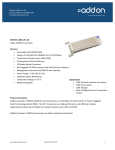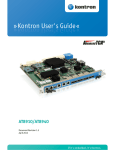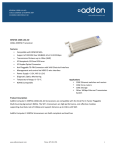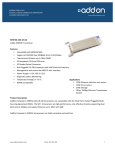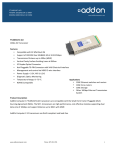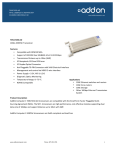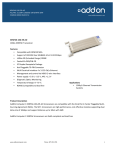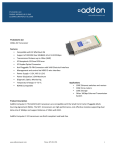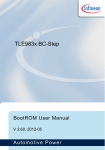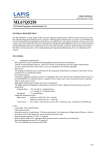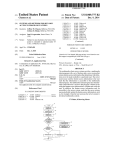Download Untitled - Mouser Electronics
Transcript
1 CONTENTS CHAPTER 1 INTRODUCTION ................................................................................................................................. 3 1.1 Features ..................................................................................................................................................................... 3 1.2 Getting Help.............................................................................................................................................................. 4 CHAPTER 2 ARCHITECTURE................................................................................................................................. 5 2.1 Block Diagram .......................................................................................................................................................... 6 CHAPTER 3 PIN DESCRIPTION ............................................................................................................................. 8 3.1 HSMC Expansion Connector .................................................................................................................................... 8 CHAPTER 4 COMPONENTS .................................................................................................................................. 17 4.1 Featured Device: BCM8727 (U6) ........................................................................................................................... 17 4.2 General User Input/Output ...................................................................................................................................... 22 4.3 Clocks ..................................................................................................................................................................... 23 4.4 Memory Devices ..................................................................................................................................................... 24 4.5 Power ...................................................................................................................................................................... 26 CHAPTER 5 BOARD SETUP AND TEST DESIGNS ............................................................................................ 27 5.1 Board Setup............................................................................................................................................................. 27 5.2 Test Designs Using Stratix IV GX FPGA Development Kit Platform .................................................................... 28 CHAPTER 6 APPENDIX ......................................................................................................................................... 35 6.1 Revision History ..................................................................................................................................................... 35 6.2 Copyright Statement................................................................................................................................................ 35 2 Chapter 1 Introduction This board is intended to be used by customers to implement and design 10G Ethernet systems based on transceiver host boards that support XAUI interfaces. This mezzanine card is intended to be part of an openly sold Development Kit and can be bundled with packages of Software and IP Cores. It will have 2 full duplex 10G SFP+ channels with a XAUI backend interface. The XAUI to SFP+ HSMC provides a hardware platform for developing embedded systems based on XAUI based Altera “GX” based devices. At the time of this document the devices that support XAUI are Arria GX, Arria II GX, Stratix II GX and Stratix IV GX. 1.1 Features Figure 1-1 shows the photo of the Dual XAUI to SFP+ HSMC board. The important features are listed below: • Two independent XAUI interfaces from the HSMC to the BCM8727 • Two independent SFI interfaces from the BCM8727 to SFP+ cages • MDIO interfaces • I2C EEPROM for HSMC identification and user data • Si5334C clock generator • 156.25MHz reference available on SMA connectors and through the HSMC connector • 4 user bi-color LEDS for each channel (8 total bi-color LEDs) 3 Figure 1-1 Picture of the Dual XAUI to SFP+ HSMC board 1.2 Getting Help Here are some places to get help if you encounter any problem: • Email to [email protected] • Taiwan & China: +886-3-550-8800 • Korea : +82-2-512-7661 • Japan: +81-428-77-7000 4 Chapter 2 Architecture This chapter describes the architecture of the Dual XAUI to SFP+ HSMC board including block diagram and components. Figure 2-1 The Dual XAUI to SFP+ HSMC PCB and component diagram A photograph of the Dual XAUI to SFP+ HSMC board is shown in Figure 2-1. It depicts the layout of the board and indicates the location of the connectors and key components. 5 2.1 Block Diagram Figure 2-2 shows the block diagram of the Dual XAUI to SFP+ HSMC board. Figure 2-2 Block diagram of the Dual XAUI to SFP+ HSMC board The XAUI interfaces will be attached to the HSMC side of the card and the SFI side of the interface will be attached to the SFP+ optical modules on the opposite side of the board. The lower HSMC channels (0 thru 3) are utilized for the XAUI connection for channel 0 and upper HSMC channels (4 thru 7) are utilized for the XAUI connection for channel 1 of the 10GE channel links. 6 Two SFP+ connectors and cages combined with a SFP+ optical module (not provided with the board) form the 10GE optical interface. The SFP+ modules communicate with the BCM8727 via the serial SFI protocol. The SFP interface connector is 20 pins. Most SFP+ optical modules will contain status and configuration registers accessible through an I2C port. Other signals will include loss of signal (OPRXLOS[2:1]) and module absent (MOD_ABS[2:1] ). An oscillator capable of generating 156.25MHz is supplied on the HSMC to provide the host board with a clean low jitter reference clock. The clock also supplies the XAUI to SFI chip set for CMU reference use. Power for the SFP+ modules and the chipset will be provided from the 12V and 3.3V power available on the HSMC connector. 7 Chapter 3 Pin Description This chapter describes the detailed information of the connector interfaces, and the pin description on the Dual XAUI to SFP+ HSMC board. 3.1 HSMC Expansion Connector The Dual XAUI to SFP+ HSMC board contains a HSMC connector. Figure 3-1, Figure 3-2 and Figure 3-3 show the pin-outs of the HSMC connector on the Dual XAUI to SFP+ HSMC board. 8 Figure 3-1 Pin-outs of Bank 1 on the HSMC connector 9 Figure 3-2 Pin-outs of Bank 2 on the HSMC connector 10 Figure 3-3 Pin-outs of Bank 3 on the HSMC connector 11 Table 3-1 shows the pin description of the HSMC connector. Table 3-1 The pin mappings of the HSMC connector HSMC Schematic Net Connections Board Signal Name IO Standard Function 125 CONFIG0_1 CMOS 127 CONFIG0_2 CMOS 131 CONFIG1_1 CMOS 133 CONFIG1_2 CMOS 137 110 139 140 68 128 116 GPIO0_1 GPIO0_2 GPIO1_1 GPIO1_2 LASI1 LASI2 MDC2 LVTTL LVTTL LVTTL LVTTL CMOS CMOS CMOS 114 MDIO2 CMOS 41 101 78 138 43 103 121 132 61 59 42 102 44 104 62 122 MISO1 MISO2 MOD_ABS1 MOD_ABS2 MOSI1 MOSI2 NVMA1SEL NVMPROT OPINLVL OPOUTLVL OPRXLOS1 OPRXLOS2 OPTXFLT1 OPTXFLT2 PCDRLK1 PCDRLK2 LVTTL LVTTL CMOS CMOS LVTTL LVTTL LVTTL CMOS LVTTL LVTTL CMOS CMOS CMOS CMOS LVTTL LVTTL Configuration mode channel 1, bit 0. Internally pulled down. Configuration mode channel 2, bit 0. Internally pulled down. Configuration mode channel 1, bit 1. Internally pulled down. Configuration mode channel 2, bit 1. Internally pulled down. Programmable general purpose I/O. Programmable general purpose I/O. Programmable general purpose I/O. Programmable general purpose I/O. Link Alarm Status Interrupt Channel 1. Link Alarm Status Interrupt Channel 2. Management Data Clock for single device (default), Management Data Clock channel 2 for dual MDIO device. Master Input/Slave Output Channel 1. Master Input/Slave Output Channel 2. Module Absent Channel 1. Module Absent Channel 2. Master Output to Slave Input channel 1. Master Output to Slave Input channel 2. Non-volatile Memory Select Non-volatile Memory Protect Optical Control Input Level. Optical Control Output Level. Optical Receiver Loss of Signal Channel 1. Optical Receiver Loss of Signal Channel 2. Optical Transmitter Fault Indicator Channel 1. Optical Transmitter Fault Indicator Channel 2. PMD CDR Lock Detect Channel 1. PMD CDR Lock Detect Channel 2. Reference Pin (J6) 12 60 120 72 66 126 77 79 73 71 67 65 47 107 50 53 PCMULK1 PCMULK2 PHYRESET PLOSB1 PLOSB2 PRTAD01 PRTAD02 PRTAD1 PRTAD2 PRTAD3 PRTAD4 SCK1 SCK2 SER_BOOT SFP_TXDIS1 113 SFP_TXDIS2 48 108 119 49 109 74 134 32 SMBSPDSEL1 SMBSPDSEL2 SMBWEN SS_N1 SS_N2 TXONOFF1 TXONOFF2 XAUI_RX_1N0 28 XAUI_RX_1N1 24 XAUI_RX_1N2 20 XAUI_RX_1N3 30 XAUI_RX_1P0 26 XAUI_RX_1P1 22 XAUI_RX_1P2 18 XAUI_RX_1P3 LVTTL LVTTL LVTTL LVTTL LVTTL CMOS CMOS CMOS CMOS CMOS CMOS LVTTL LVTTL LVTTL LVTTL, Open drain LVTTL, Open drain LVTTL LVTTL LVTTL LVTTL LVTTL CMOS CMOS Differential CML Differential CML Differential CML Differential CML Differential CML Differential CML Differential CML Differential CML PMD CMU Lock Detect Channel 1. PMD CMU Lock Detect Channel 2. PHY Reset, Active low. PMD Loss of Signal Channel 1. PMD Loss of Signal Channel 2. Channel 1 PHY Address LSB. Channel 2 PHY Address LSB PHY Address bit 1. PHY Address bit 2. PHY Address bit 3. PHY Address bit 4. SPI ROM Clock for channel 1. SPI ROM Clock for channel 2. SPI ROM Boot Enable active high. Optical Transmitter Enable channel 1. Optical Transmitter Enable channel 2. 2-wire Speed Select channel 1. 2-wire Speed Select channel 2. 2-wire Write Enable, SPI ROM Chip Select channel 1. SPI ROM Chip Select channel 2. Transmit Driver On or Off channel 1. Transmit Driver On or Off channel 2. XAUI Parallel Receive Data Output Channel 1, lane D, negative leg. XAUI Parallel Receive Data Output Channel 1, lane C, negative leg. XAUI Parallel Receive Data Output Channel 1, lane B, negative leg. XAUI Parallel Receive Data Output Channel 1, lane A, negative leg. XAUI Parallel Receive Data Output Channel 1, lane D, positive leg. XAUI Parallel Receive Data Output Channel 1, lane C, positive leg. XAUI Parallel Receive Data Output Channel 1, lane B, positive leg. XAUI Parallel Receive Data Output Channel 1, lane A, positive leg. 13 16 XAUI_RX_2N0 12 XAUI_RX_2N1 8 XAUI_RX_2N2 4 XAUI_RX_2N3 14 XAUI_RX_2P0 10 XAUI_RX_2P1 6 XAUI_RX_2P2 2 XAUI_RX_2P3 31 XAUI_TX_1N0 27 XAUI_TX_1N1 23 XAUI_TX_1N2 19 XAUI_TX_1N3 29 XAUI_TX_1P0 25 XAUI_TX_1P1 21 XAUI_TX_1P2 17 XAUI_TX_1P3 15 XAUI_TX_2N0 11 XAUI_TX_2N1 7 XAUI_TX_2N2 3 XAUI_TX_2N3 13 XAUI_TX_2P0 Differential CML Differential CML Differential CML Differential CML Differential CML Differential CML Differential CML Differential CML Differential CML Differential CML Differential CML Differential CML Differential CML Differential CML Differential CML Differential CML Differential CML Differential CML Differential CML Differential CML Differential CML XAUI Parallel Receive Data Output Channel 2, lane D, negative leg. XAUI Parallel Receive Data Output Channel 2, lane C, negative leg. XAUI Parallel Receive Data Output Channel 2, lane B, negative leg. XAUI Parallel Receive Data Output Channel 2, lane A, negative leg. XAUI Parallel Receive Data Output Channel 2, lane D, positive leg. XAUI Parallel Receive Data Output Channel 2, lane C, positive leg. XAUI Parallel Receive Data Output Channel 2, lane B, positive leg. XAUI Parallel Receive Data Output Channel 2, lane A, positive leg. XAUI Parallel Transmit Data Input Channel 1, lane D, negative leg. XAUI Parallel Transmit Data Input Channel 1, lane C, negative leg. XAUI Parallel Transmit Data Input Channel 1, lane B, negative leg. XAUI Parallel Transmit Data Input Channel 1, lane A, negative leg. XAUI Parallel Transmit Data Input Channel 1, lane D, positive leg. XAUI Parallel Transmit Data Input Channel 1, lane C, positive leg. XAUI Parallel Transmit Data Input Channel 1, lane B, positive leg. XAUI Parallel Transmit Data Input Channel 1, lane A, positive leg. XAUI Parallel Transmit Data Input Channel 2, lane D, negative leg. XAUI Parallel Transmit Data Input Channel 2, lane C, negative leg. XAUI Parallel Transmit Data Input Channel 2, lane B, negative leg. XAUI Parallel Transmit Data Input Channel 2, lane A, negative leg. XAUI Parallel Transmit Data Input Channel 2, lane D, positive leg. 14 9 XAUI_TX_2P1 5 XAUI_TX_2P2 1 XAUI_TX_2P3 80 CLK_OE 158 HSM_CLK_N 156 HSM_CLK_P 160 HSM_PSNTN 37 38 56 JTAG_TDO_TDI JTAG_TDO_TDI MDC1 Differential CML Differential CML Differential CML XAUI Parallel Transmit Data Input Channel 2, lane C, positive leg. XAUI Parallel Transmit Data Input Channel 2, lane B, positive leg. XAUI Parallel Transmit Data Input Channel 2, lane A, positive leg. Clock Output Enable, active low. Enables the Si5334C clock buffer HSMC Differential Clock output to the host board, negative leg. HSMC Differential Clock output to the host board, positive leg. HSMC Present, active low. Illuminates the HSMC Present LED on the host board when this card is plugged into the host JTAG TDO Looped back to TDI pin 38. JTAG TDI Looped back to TDO pin 37. No Connect for single MDIO device (default), Management Data Clock channel 1 for dual MDIO device. No Connect for single MDIO device (default), Management Data I/O channel 1 for dual MDIO device. Rate Select 0 for SFP+ module receiver channel 1, pulled high via R59. This sets the input rate > 4.25 GBd, pull low for rates ≤ 4.25 GBd. Rate Select 0 for SFP+ module receiver channel 2, pulled high via R3. This sets the input rate > 4.25 GBd, pull low for rates ≤ 4.25 GBd. CLKIN to Si5334 device GND pin on Si5334C, drive this pin low. Optional clock pin when using Si5338. EEPROM SCL, for future use EEPROM SDA, for future use User LED Green 0 User LED Green 1 User LED Green 2 User LED Green 3 User LED Green 4 User LED Green 5 LVCMOS CMOS 54 MDIO1 CMOS 55 SFP_TXRS10 CMOS 115 SFP_TXRS20 CMOS 95 155 SI5338_CLKIN SI5338_SCL CMOS GND 34 33 92 90 86 84 152 150 SMB_SCL SMB_SDA USER_LED_G0 USER_LED_G1 USER_LED_G2 USER_LED_G3 USER_LED_G4 USER_LED_G5 CMOS CMOS CMOS CMOS CMOS CMOS CMOS CMOS 15 146 144 91 89 85 83 151 149 145 143 USER_LED_G6 USER_LED_G7 USER_LED_R0 USER_LED_R1 USER_LED_R2 USER_LED_R3 USER_LED_R4 USER_LED_R5 USER_LED_R6 USER_LED_R7 CMOS CMOS CMOS CMOS CMOS CMOS CMOS CMOS CMOS CMOS User LED Green 6 User LED Green 7 User LED Red 0 User LED Red 1 User LED Red 2 User LED Red 3 User LED Red 4 User LED Red 5 User LED Red 6 User LED Red 7 16 Chapter 4 Components This section introduces all of the important components on the XAUI to SFP+ HSMC board. 4.1 Featured Device: BCM8727 (U6) The BCM8727 is a dual-channel 10-GbE SFI-to-XAUI™ transceiver that incorporates an Electronic Dispersion Compensation (EDC) equalizer supporting SFP+ line-card applications. The BCM8727 is a multi-rate PHY targeted for SMF, MMF, or copper twin-ax applications interfacing to both limiting-based and linear-based SFP+ and SFP modules. The BCM8727 is fully compliant to the 10-GbE IEEE 802.3aq standard and also supports 1000BASE-X for 1- GbE operation. The BCM8727 is developed using an all-DSP high-speed front-end providing the highest performance and most flexibility for line-card designers. An on-chip microcontroller implements the control algorithm for the DSP core. All signal names and BCM8727 pin positions are located in Table 3-1. Table 4-1 BCM8727 Schematic Net Connections Board Reference Signal Name IO Standard Function K9 CONFIG0_1 CMOS K11 CONFIG0_2 CMOS J9 CONFIG1_1 CMOS J10 CONFIG1_2 CMOS L9 G13 M9 H13 GPIO0_1 GPIO0_2 GPIO1_1 GPIO1_2 LVTTL LVTTL LVTTL LVTTL Configuration mode channel 1, bit 0. Internally pulled down. Configuration mode channel 2, bit 0. Internally pulled down. Configuration mode channel 1, bit 1. Internally pulled down. Configuration mode channel 2, bit 1. Internally pulled down. Programmable general purpose I/O. Programmable general purpose I/O. Programmable general purpose I/O. Programmable general purpose I/O. Pin (U6) 17 E7 K10 D8 LASI1 LASI2 MDC2 CMOS CMOS CMOS E8 MDIO2 CMOS G5 G12 G10 N8 F5 F12 G7 MISO1 MISO2 MOD_ABS1 MOD_ABS2 MOSI1 MOSI2 NC/MDC_1 LVTTL LVTTL CMOS CMOS LVTTL LVTTL CMOS G8 NC/MDIO_1 CMOS M1 G9 E10 D10 L4 NVMA1SEL NVMPROT OPINLVL OPOUTLVL OPRXLOS1 LVTTL CMOS LVTTL LVTTL CMOS L12 OPRXLOS2 CMOS H8 OPTXFLT1 CMOS J14 OPTXFLT2 CMOS K4 K12 H6 M12 G6 L11 R10 OPTXRST1_1 OPTXRST1_2 PCDRLK1 PCDRLK2 PCMULK1 PCMULK2 PEXTCLK156_N LVTTL LVTTL LVTTL LVTTL LVTTL LVTTL T10 PEXTCLK156_P Link Alarm Status Interrupt Channel 1. Link Alarm Status Interrupt Channel 2. Management Data Clock single device (default), Management Data Clock channel 2 for dual MDIO device. Management Data I/O for single MDIO device (default), Management Data I/O channel 2 for dual MDIO device. Master Input/Slave Output Channel 1. Master Input/Slave Channel 2. Module Absent Channel 1. Module Absent Channel 2. Master Output to Slave Input channel 1. Master Output to Slave Input channel 2. No Connect for single MDIO device (default), Management Data Clock channel 1 for dual MDIO device. No Connect for single MDIO device (default), Management Data I/O channel 1 for dual MDIO device. Non-volatile Memory Select Non-volatile Memory Protect Optical Control Input Level. Optical Control Output Level. Optical Receiver Loss of Signal Channel 1. Optical Receiver Loss of Signal Channel 2. Optical Transmitter Fault Indicator Channel 1. Optical Transmitter Fault Indicator Channel 2. Optical Module Reset Channel 1. Optical Module Reset Channel 2. PMD CDR Lock Detect Channel 1. PMD CDR Lock Detect Channel 2. PMD CMU Lock Detect Channel 1. PMD CMU Lock Detect Channel 2.. Reference Clock Channel negative leg of a differential clock. Reference Clock Channel positive leg of a 18 E9 H5 H11 A10 A9 B9 C9 B10 C10 T14 R14 V1 PHYRESET PLOSB1 PLOSB2 PRTAD01 PRTAD02 PRTAD1 PRTAD2 PRTAD3 PRTAD4 RB_CAL RB_CAL_VSS RCLKN_1 V10 RCLKN_2 U1 RCLKP_1 V9 RCLKP_2 T8 V18 K5 M11 H10 V7 RDICM_1 RDICM_2 SCK1 SCK2 SER_BOOT SFI_RX_N1 V16 SFI_RX_N2 V6 SFI_RX_P1 V15 SFI_RX_P2 V3 SFI_TX_N1 V12 SFI_TX_N2 V4 SFI_TX_P1 V13 SFI_TX_P2 differential clock.. PHY Reset, Active low. PMD Loss of Signal Channel 1. PMD Loss of Signal Channel 2. Channel 1 PHY Address LSB. Channel 2 PHY Address LSB PHY Address bit 1. PHY Address bit 2. PHY Address bit 3. PHY Address bit 4. Not used. Not used. Analog Recovered Clock from CDR Channel 1 negative leg. Analog Recovered Clock from CDR Channel 2 negative leg. Analog Recovered Clock from CDR Channel 1 positive leg. Analog Recovered Clock from CDR Channel 2 positive leg. Receiver Common Mode Input channel 1. Receiver Common Mode Input channel 2.. SPI ROM Clock for channel 1. SPI ROM Clock for channel 2. SPI ROM Boot Enable active high. Receiver Serial Data channel 1, negative leg. LVTTL LVTTL LVTTL CMOS CMOS CMOS CMOS CMOS CMOS Analog Analog Differential CML Differential CML Differential CML Differential CML Analog Analog LVTTL LVTTL LVTTL Differential CML Differential CML Differential CML Differential CML Differential CML Differential CML Differential CML Differential CML Receiver Serial Data channel 2, negative leg. Receiver Serial Data channel 1, positive leg. Receiver Serial Data channel 2, positive leg. Transmitter Serial Data channel 1, negative leg. Transmitter Serial Data channel 2, negative leg. Transmitter Serial Data channel 1, positive leg. Transmitter Serial Data channel 2, positive leg. 19 J4 SFP_TXDIS1 J12 SFP_TXDIS2 F9 SMBSCL1 F11 SMBSCL2 F8 SMBSDA1 F10 SMBSDA2 K8 J15 F7 L5 N11 K13 SMBSPDSEL1 SMBSPDSEL2 SMBWEN SS_N1 SS_N2 TRSTB F6 E12 A1 TXONOFF1 TXONOFF2 XAUI_RX_1N0 A3 XAUI_RX_1N1 A5 XAUI_RX_1N2 A7 XAUI_RX_1N3 B1 XAUI_RX_1P0 B3 XAUI_RX_1P1 B5 XAUI_RX_1P2 B7 XAUI_RX_1P3 LVTTL, Open drain LVTTL, Open drain LVTTL, Open drain LVTTL, Open drain LVTTL, Open drain LVTTL, Open drain LVTTL LVTTL LVTTL LVTTL LVTTL LVTTL Optical Transmitter Enable channel 1. Optical Transmitter Enable channel 2. Serial Clock channel 1. Serial Clock channel 2. Serial Data channel 1. Serial Data channel 2. 2-wire Speed Select channel 1. 2-wire Speed Select channel 2. 2-wire Write Enable, SPI ROM Chip Select channel 1. SPI ROM Chip Select channel 2. JTAG Test Reset pin, JTAG interface not used for this design. Transmit Driver On or Off channel 1. Transmit Driver On or Off channel 2. XAUI Parallel Receive Data Output Channel 1, lane D, negative leg. XAUI Parallel Receive Data Output Channel 1, lane C, negative leg. XAUI Parallel Receive Data Output Channel 1, lane B, negative leg. XAUI Parallel Receive Data Output Channel 1, lane A, negative leg. XAUI Parallel Receive Data Output Channel 1, lane D, positive leg. XAUI Parallel Receive Data Output Channel 1, lane C, positive leg. XAUI Parallel Receive Data Output Channel 1, lane B, positive leg. XAUI Parallel Receive Data Output Channel CMOS CMOS Differential CML Differential CML Differential CML Differential CML Differential CML Differential CML Differential CML Differential 20 D18 XAUI_RX_2N0 F18 XAUI_RX_2N1 H18 XAUI_RX_2N2 K18 XAUI_RX_2N3 D17 XAUI_RX_2P0 F17 XAUI_RX_2P1 H17 XAUI_RX_2P2 K17 XAUI_RX_2P3 K2 XAUI_TX_1N0 H2 XAUI_TX_1N1 F2 XAUI_TX_1N2 D2 XAUI_TX_1N3 K1 XAUI_TX_1P0 H1 XAUI_TX_1P1 F1 XAUI_TX_1P2 D1 XAUI_TX_1P3 B12 XAUI_TX_2N0 B14 XAUI_TX_2N1 B16 XAUI_TX_2N2 B18 XAUI_TX_2N3 A12 XAUI_TX_2P0 CML Differential CML Differential CML Differential CML Differential CML Differential CML Differential CML Differential CML Differential CML Differential CML Differential CML Differential CML Differential CML Differential CML Differential CML Differential CML Differential CML Differential CML Differential CML Differential CML Differential CML Differential 1, lane A, positive leg. XAUI Parallel Receive Data Output Channel 2, lane D, negative leg. XAUI Parallel Receive Data Output Channel 2, lane C, negative leg. XAUI Parallel Receive Data Output Channel 2, lane B, negative leg. XAUI Parallel Receive Data Output Channel 2, lane A, negative leg. XAUI Parallel Receive Data Output Channel 2, lane D, positive leg. XAUI Parallel Receive Data Output Channel 2, lane C, positive leg. XAUI Parallel Receive Data Output Channel 2, lane B, positive leg. XAUI Parallel Receive Data Output Channel 2, lane A, positive leg. XAUI Parallel Transmit Data Input Channel 1, lane D, negative leg. XAUI Parallel Transmit Data Input Channel 1, lane C, negative leg. XAUI Parallel Transmit Data Input Channel 1, lane B, negative leg. XAUI Parallel Transmit Data Input Channel 1, lane A, negative leg. XAUI Parallel Transmit Data Input Channel 1, lane D, positive leg. XAUI Parallel Transmit Data Input Channel 1, lane C, positive leg. XAUI Parallel Transmit Data Input Channel 1, lane B, positive leg. XAUI Parallel Transmit Data Input Channel 1, lane A, positive leg. XAUI Parallel Transmit Data Input Channel 2, lane D, negative leg. XAUI Parallel Transmit Data Input Channel 2, lane C, negative leg. XAUI Parallel Transmit Data Input Channel 2, lane B, negative leg. XAUI Parallel Transmit Data Input Channel 2, lane A, negative leg. XAUI Parallel Transmit Data Input Channel 21 A14 XAUI_TX_2P1 A16 XAUI_TX_2P2 A18 XAUI_TX_2P3 CML Differential CML Differential CML Differential CML 2, lane D, positive leg. XAUI Parallel Transmit Data Input Channel 2, lane C, positive leg. XAUI Parallel Transmit Data Input Channel 2, lane B, positive leg. XAUI Parallel Transmit Data Input Channel 2, lane A, positive leg. 4.2 General User Input/Output This board has eight dual color (Green/Red) surface mount LEDs are provided for general purpose use. - A logic 0 is driven on the I/O port to turn the LED ON. - A logic 1 is driven on the I/O port to turn the LED OFF. Table 4-2 lists the assignment for each users LED and describes board reference description signaling standard and schematic name for the USER LEDs located on the HSMC. These are all 2.5V LVCMOS signals. Each channel has a bi-colored LED. The 4 states of each bi-color LED (Off, green, red, orange) can be used to identify received or transmitted rate or any other state that the user would like. The LEDs are driven from user logic located inside the host device on the host board. Table 4-2 User LED Pinout (Green/Red) Board Reference D5 D6 D7 D8 D1 D2 D3 D4 Signal Name IO Standard Function USER_LED_R0 USER_LED_G0 USER_LED_R1 USER_LED_G1 USER_LED_R2 USER_LED_G2 USER_LED_R3 USER_LED_G3 USER_LED_R4 USER_LED_G4 USER_LED_R5 USER_LED_G5 USER_LED_R6 USER_LED_G6 USER_LED_R7 USER_LED_G7 3.3V 3.3V 3.3V 3.3V 3.3V 3.3V 3.3V 3.3V 3.3V 3.3V 3.3V 3.3V 3.3V 3.3V 3.3V 3.3V User defined User defined User defined User defined User defined User defined User defined User defined User defined User defined User defined User defined User defined User defined User defined User defined 22 4.3 Clocks Figure 4-1 shows the XAUI to SFP+ HSMC board clock diagram. Figure 4-1 XAUI to SFP+ HSMC Clocking Diagram 23 All signal names and clock pin positions are located in Table 4-3. Table 4-3 XAUI to SFP+ HSMC Board Clock Distribution Signal Frequency Signal Name Signal Propagates To Originates From 156.25 MHz HSM_CLK_P HSM_CLK_N U16.13 U16.14 156.25 MHz PEXTCLK156_P PEXTCLK156_N U16.17 U16.18 156.25 MHz CLK0_P CLK0_N U16.21 U16.22 J16.156 J16.158 U6.T10 U6.R10 J7 J8 4.4 Memory Devices This section describes the board’s memory interface support, and their signal names, types, and connectivity relative to the interface they are connected to. The board has the following memory interfaces: 8K EEPROM (connected to HSMC) 2 x 256K SPI EEPROM (connected to BCM8727 and HSMC) 2 x 4K EEPROM (connected to BCM8727 and SFP+) The 8K EEPROM intended use is to identify the board when it is plugged into the host board. All signal names and memory pin positions are located in Table 4-4, Table 4-5, and Table 4-6. Table 4-4 8 Kbit Serial I2C EEPROM (24LC08B) Pinout Board Reference U18.1 U18.2 U18.3 U18.4 U18.5 U18.6 U18.7 U18.8 Signal Name IO Standard Function GND GND GND GND SMB_SDA SMB_SCL GND VCC GND GND GND GND 3.3V 3.3V GND 3.3V Address bus bit 0 Address bus bit 1 Address bus bit 2 Ground Serial Data Serial Clock Write Protect 3.3V Power Supply 24 Table 4-5 256 Kbit Serial SPI EEPROM (25LC256IST) Pinout Board Signal Name IO Standard Function U14.1, U15.1 U14.2, U15.2 U14.3, U15.3 SS_N1 SS_N2 MISO1 MISO2 Pull-up resistor to 3.3V 3.3V Chip Select (Active low) 3.3V Serial Data Output 3.3V Write Protect (Active low) U14.4, U15.4 U14.5, U15.5 U14.6, U15.6 U14.7, U15.7 GND GND Ground MOSI1 MOSI2 SCK1, SCK2 Pull-up resistor to 3.3V 3.3V Serial Data Input 3.3V Serial Clock Input 3.3V Hold Input (Active low) U14.8, U15.8 3.3V 3.3V Supply Voltage Reference Table 4-6 4 Kbit Serial I2C EEPROM (24LC08B) Pinout Board Reference U10.1, U11.1 U10.2, U11.2 U10.3, U11.3 U10.4, U11.4 U10.5, U11.5 U10.6, U11.6 U10.7, U11.7 U10.8, U11.8 Signal Name IO Standard Function GND GND Address bus bit 0 Pull-up resistor to 3.3V Pull-down resistor to GND GND 3.3V Address bus bit 1 GND Address bus bit 2 GND Ground SMBSDA1, SMBSDA2 SMBSCL1, SMBSCL2 Pull-down resistor to GND VCC 3.3V Serial Data 3.3V Serial Clock GND Write Protect 3.3V 3.3V Power Supply 25 4.5 Power Power is supplied to the board from the 12V supply of the host board. Figure 4-2 shows the power distribution. Figure 4-2 Power Tree of Dual XAUI to SFP+ HSMC Board 26 Chapter 5 Board Setup and Test Designs Two host platforms that this board has successfully been tested on are the Stratix IV GX production device development kit and the Arria II GX development kit. The Arria II GX development kit only utilizes the HSMC port A, so this kit can only use SFP+ port 1. The Arria II GX development kit 6G edition allows the use of HSMC port A and port B, so that it may be possible to use both SFP+ ports 1 and 2. However, the 6G edition kit has not been tested in hardware. 5.1 Board Setup Before powering on the host board on, make sure to install a shunt on J13 and J14. Then plug the HSMC board into the host board. This board was designed so that Si5338 or the Si5334C (default) may be installed in position U16. Table 5-1 XAUI to SFP+ HSMC Board Setup Board Signal Name IO Standard Function J13 Si5338_SCL 3.3V J14 CLK_OE 3.3V When using the Si5334C (default) this pin is a ground pin. It must be pulled to GND. When using the Si5338 device this pin is SCL. When using the Si5334C (default) this pin is output enable (OEB, active low). When pulled low all programmed outputs are active. When using the Si5338 device this pin is SDA. Reference 27 5.2 Test Designs Using Stratix IV GX FPGA Development Kit Platform XAUI to SFP+ Module 10G Channel Optical Loopback This design tests the dual XAUI to SFI interface using the Stratix IV GX FPGA Dev Kit platform. The Stratix IV GX transmits and receives 3.125G XAUI signals on four transceivers for each of the two channels utilized. For each channel the Stratix IV GX FPGA sends a 3.125G XAUI signal on four transmit channels to the BCM8727 device, which then outputs a 10G signal to the SFP+ module. With an SFP+ module and optical cable installed, as shown in Figure 5-1, the SFP+ sends an optical 10G signal onto the optical fiber which is looped back into the SFP+ optical input. The SFP+ module converts the 10G optical signal into an electrical 10G signal and sends it to the BCM8727 PHY. The PHY then converts the 10G signal into four 3.125G XAUI output signals and transmits them to the Stratix IV GX device through the HSMC connector. Figure 5-1 XAUI to SFP+ Channel Optical Loopback Test Setup XAUI to SFP+ Module 10G Channel Optical Loopback Test Design Procedure 1) Set USER_DIPSW[7:0] = [00000100] -- Flip XAUI Lanes 2) Plug in the Dual XAUI to SFP+ HSMC into the HSMA port on the Stratix IV GX FPGA development 3) Plug in SFP+ modules into each SFP+ port on the Dual XAUI to SFP+ HSMC 4) Plug in two 10G Loopback cables compatible with the SPF+ modules 28 5) Power on the Stratix IV GX FPGA development kit board 6) Program the Stratix IV GX FPGA development kit with the "hsmc_loopback.sof" On the Stratix IV GX FPGA development kit: 7) Press and release cpu_resetn (S2). 8) Press and release user_pb[0] -- the rx is now ready to search for a prbs seed pattern 9) Press and release both cpu_resetn, user_pb[1] and user_pb[2] simultaneously - Resets the BCM8727C device and the + SFP module(s) 10) Reset Module (It should be OK to skip this one, but include these steps if your board is failing) A) Set USER_DIPSW[7:0] = [00000000] (Program MDIO to reset module) B) Press and release user_pb[1] C) Press and release user_pb[2] 11) To Flip XAUI Lanes A) Set USER_DIPSW[7:0] = [00000100] (Program MDIO to flip XAUI lanes) B) Press and release user_pb[1] C) Press and release user_pb[2] 12) Set pre-emphasis (for example, if using an SFP+ 12 meter cable) A) USER_DIPSW[7:0] = [11100110] B) Press and release user_pb[1] C) Press and release user_pb[2] 13) Press and release cpu_resetn 14) LEDs 15-8 will display the "heartbeat" pattern, indicating the FPGA fabric is functional. 15) LED 0 and 4 should be ON and LEDs 1-3 and 5-7 should be OFF. 16) Press and release user_pb[0] (Start Test) 17) LEDs 0-2 and 4-6 should all be ON and LEDs 3 and 7 should be OFF. 18) Unplug the RX optical cable from the channel 1 SFP port. 19) LED 3 should turn ON. 20) Unplug the RX optical cable from the channel 2 SFP port. 21) LED 7 should turn ON. NOTE: If the test doesn't pass for example with the 12 meter SFP cable, it is ok to try different settings of USER_DIPSW[7:3] in step 12 above to make the test pass. To test the daughter card LEDs, observe they follow LEDs 15-8 on the host board in step 8 above. Pressing user_pb[0] reverses the color of USER LEDS 0-3 on the daughtercard Pressing user_pb[1] reverses the color of USER LEDS 4-7 on the daughtercard 29 XAUI to SFP+ Module 10G Channel-to-Channel Optical Loopback This design tests the dual XAUI to SFI interface using the Stratix IV GX FPGA Dev Kit platform. The Stratix IV GX transmits 3.125G XAUI signals on the four lanes of channel 1 and the return signal is received on channel 2. Also, the Stratix IV GX transmits 3.125G XAUI signals on the four lanes of channel 2 and the return signal is received on channel 1. The Stratix IV GX FPGA sends a 3.125G XAUI signal on four transmit lanes from channel 1 to the BCM8727 device, which then outputs a 10G signal to the SFP+ module on channel 1. With an SFP+ module and optical cable installed, as shown in Figure 5-2, the SFP+ sends an optical 10G signal from SFP+ channel 1 output to SFP+ channel 2 input. The SFP+ module converts the 10G optical signal into an electrical 10G signal and sends it to the BCM8727 PHY. The PHY then converts the 10G signal into four 3.125G XAUI output signals and transmits them on channel 2 to the Stratix IV GX device through the HSMC connector. The same process is followed for the channel 2 transmitter to channel 1 receiver. Figure 5-2 XAUI to SFP+ Channel-to-Channel Loopback Test Setup XAUI to SFP+ Module 10G Channel-to-Channel Loopback Test Design Procedure (The same steps are followed for the Channel Loopback test above, except to Step 20) 1) Set USER_DIPSW[7:0] = [00000100] -- Flip XAUI Lanes 2) Plug in the Dual XAUI to SFP+ HSMC into the HSMA port on the Stratix IV GX FPGA development 3) Plug in SFP+ modules into each SFP+ port on the Dual XAUI to SFP+ HSMC 4) Plug in two 10G Optical Loopback cables compatible with the SPF+ modules 5) Power on the Stratix IV GX FPGA development kit board 6) Program the Stratix IV GX FPGA development kit with the "hsmc_loopback.sof" On the Stratix IV GX FPGA development kit: 30 7) Press and release cpu_resetn (S2). 8) Press and release user_pb[0] -- the rx is now ready to search for a prbs seed pattern 9) Press and release both cpu_resetn, user_pb[1] and user_pb[2] simultaneously - Resets the BCM8727C device and the + SFP module(s) 10) Reset Module (It should be OK to skip this one, but include these steps if your board is failing) A) Set USER_DIPSW[7:0] = [00000000] (Program MDIO to reset module) B) Press and release user_pb[1] C) Press and release user_pb[2] 11) To Flip XAUI Lanes A) Set USER_DIPSW[7:0] = [00000100] (Program MDIO to flip XAUI lanes) B) Press and release user_pb[1] C) Press and release user_pb[2] 12) Set pre-emphasis (for example, if using an SFP+ 12 meter cable) A) USER_DIPSW[7:0] = [11100110] B) Press and release user_pb[1] C) Press and release user_pb[2] 13) Press and release cpu_resetn 14) LEDs 15-8 will display the "heartbeat" pattern, indicating the FPGA fabric is functional. 15) LED 0 and 4 should be ON and LEDs 1-3 and 5-7 should be OFF. 16) Press and release user_pb[0] (Start Test) 17) LEDs 0-2 and 4-6 should all be ON and LEDs 3 and 7 should be OFF. 18) Unplug the RX optical cable from the channel 1 SFP port. 19) LED 3 should turn ON. 20) Unplug the TX optical cable from the channel 1 SFP port. 21) LED 7 should turn ON. NOTE: If the test doesn't pass for example with the 12 meter SFP cable, it is ok to try different settings of USER_DIPSW[7:3] in step 12 above to make the test pass. To test the daughter card LEDs, observe they follow LEDs 15-8 on the host board in step 8 above. Pressing user_pb[0] reverses the color of USER LEDS 0-3 on the daughtercard Pressing user_pb[1] reverses the color of USER LEDS 4-7 on the daughtercard XAUI to SFP+ Module 10G Channel-to-Channel Electrical Loopback This design tests the dual XAUI to SFI interface using the Stratix IV GX FPGA Dev Kit platform. The Stratix IV GX transmits 3.125G XAUI signals on the four lanes of channel 1 and the return signal is received on channel 2. Also, the Stratix IV GX transmits 3.125G XAUI signals on the four lanes of channel 2 and the return signal is received on channel 1. The Stratix IV GX FPGA sends a 3.125G XAUI signal on four transmit lanes from channel 1 to the BCM8727 device, which then outputs a 10G signal to the SFP+ module on channel 1. With an SFP+ module coax electrical cable installed such as the Amphenol part number SF-SFPP2EPASS-002 or SFSFPP2EPASS- 012, as shown in Figure 5-3, the SFP+ sends an electrical 10G signal from SFP+ channel 1 output to SFP+ 31 channel 2 input. The SFP+ module receives the 10G electrical and sends it to the BCM8727 PHY. The PHY then converts the 10G signal into four 3.125G XAUI output signals and transmits them on channel 2 to the Stratix IV GX device through the HSMC connector. The same process is followed for the channel 2 transmitter to channel 1 receiver. Figure 5-3 XAUI to SFP+ Channel-to-Channel Electrical Loopback Test Setup XAUI to SFP+ Module 10G Channel-to-Channel Electrical Loopback Test Design Procedure (The same steps are followed for the Channel Loopback test above, except Step 20 from above is removed. The reason this is that the electrical cable unplugs for transmit and receive at the same time.) 1) Set USER_DIPSW[7:0] = [00000100] -- Flip XAUI Lanes 2) Plug in the Dual XAUI to SFP+ HSMC into the HSMA port on the Stratix IV GX FPGA development 3) Plug in SFP+ modules into each SFP+ port on the Dual XAUI to SFP+ HSMC 4) Power on the Stratix IV GX FPGA development kit board 5) Program the Stratix IV GX FPGA development kit with the "hsmc_loopback.sof" On the Stratix IV GX FPGA development kit: 7) Press and release cpu_resetn (S2). 8) Press and release user_pb[0] -- the rx is now ready to search for a prbs seed pattern 9) Press and release both cpu_resetn, user_pb[1] and user_pb[2] simultaneously - Resets the BCM8727C device and the + SFP module(s) 10) Reset Module (It should be OK to skip this one, but include these steps if your board is failing) A) Set USER_DIPSW[7:0] = [00000000] (Program MDIO to reset module) B) Press and release user_pb[1] 32 C) Press and release user_pb[2] 11) To Flip XAUI Lanes A) Set USER_DIPSW[7:0] = [00000100] (Program MDIO to flip XAUI lanes) B) Press and release user_pb[1] C) Press and release user_pb[2] 12) Set pre-emphasis (for example, if using an SFP+ 12 meter cable) A) USER_DIPSW[7:0] = [11100110] B) Press and release user_pb[1] C) Press and release user_pb[2] 13) Press and release cpu_resetn 14) LEDs 15-8 will display the "heartbeat" pattern, indicating the FPGA fabric is functional. 15) LED 0 and 4 should be ON and LEDs 1-3 and 5-7 should be OFF. 16) Press and release user_pb[0] (Start Test) 17) LEDs 0-2 and 4-6 should all be ON and LEDs 3 and 7 should be OFF. 18) Unplug the cable from any SFP port. 19) LEDs 3 and 7 should turn ON. NOTE: If the test doesn't pass for example with the 12 meter SFP cable, it is ok to try different settings of USER_DIPSW[7:3] in step 12 above to make the test pass. To test the daughter card LEDs, observe they follow LEDs 15-8 on the host board in step 8 above. Pressing user_pb[0] reverses the color of USER LEDS 0-3 on the daughtercard Pressing user_pb[1] reverses the color of USER LEDS 4-7 on the daughtercard MDIO Functionality Check 1) Open the Quartus II “hsmc_loopback.qar” file 2) After completing one of the test designs above, open the signal tap design. a. With the “hsmc_loopback.qar” project open, locate the signal tap file named “hsmc_loopback_sfp2_mdio.stp” (or possibly hsmc_loopback_sfp3_mdio.stp). This file can be found under the “Files” tab in the Project Navigator window within Quartus II. b. Make sure the JTAG is setup 3) Set USER_DIPSW[7:0] = [XXXX0111] to read back chip rev, chip ID, and microcode ID 4) In the upper left tool bar in Signaltap click on the “Run Anaylsis” button 5) Press and release user_pb[1] 6) Press and release user_pb[2] 7) Scroll to the net named *|mdio_read_data_w. 8) Zoom in to view the values and find the value of 8727h. 33 Figure 5-4 Signal Tap Display 34 Chapter 6 Appendix 6.1 Revision History Version V1.0 Change Log Initial Version (Preliminary) 6.2 Copyright Statement Copyright © 2010 Terasic Technologies. All rights reserved. 35



































